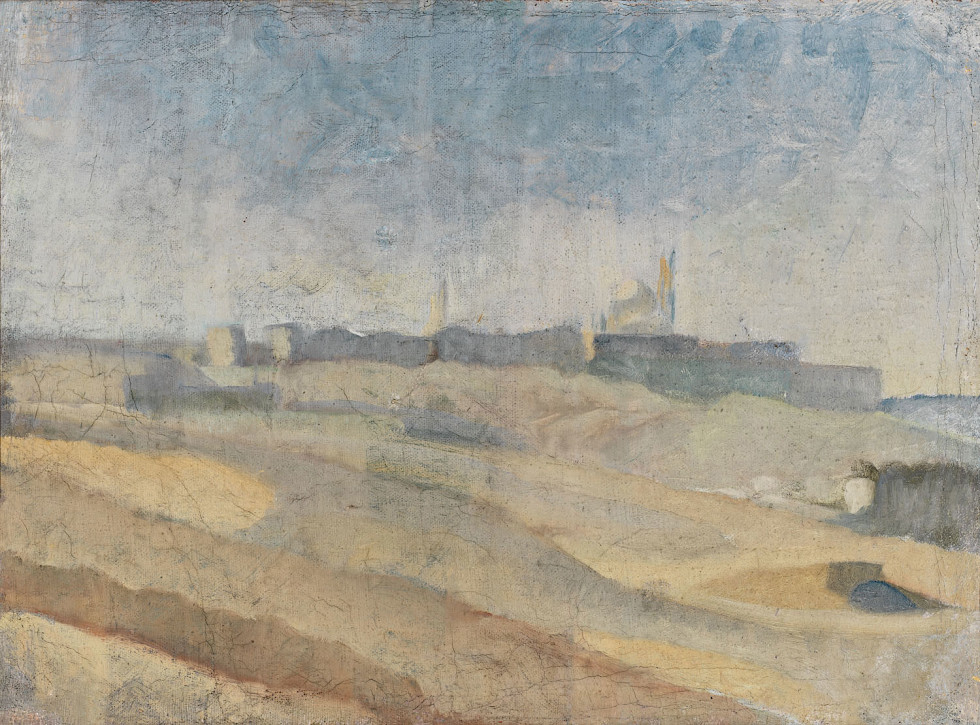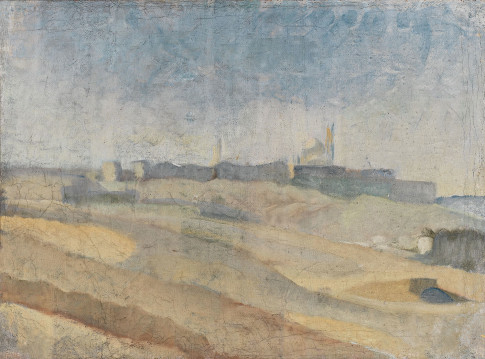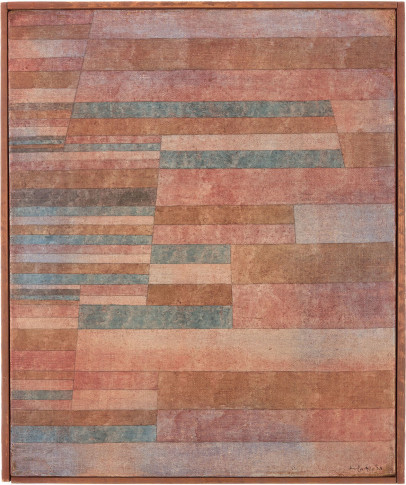
Ivan Aguéli, The City in the Hills (Egyptian Landscape), ca 1895 Photo: Juan Luis Sánchez/Moderna Museet
Ivan Aguéli’s life year by year
1869 John Gustaf Agelii is born on 24 May in Sala. His father is the veterinary Johan Gabriel Agelii (1821–1896) and his mother is Anna Stina (1838–?), née Nyberg.
1879-88 Due to bad school reports, he is moved between different schools in Sala, Västerås, Falun and Visby.
1888 Wants to paint, but his father objects. Attends a vocational school, Praktiska Arbetsskolan, at Brunkebergstorg in Stockholm.
1889 Returns to Gotland in the summer. Paints landscapes and street scenes. Meets Richard Bergh (1858–1919) and Karl Nordström (1855–1923), forming lifelong friendships with the two artists. Returns to Stockholm after summer. Reads Russian writers and Emanuel Swedenborg.
1890 Back to Gotland, where he paints his first portrait of a young woman he will paint many times, for instance in Portrait of a Girl. Gains his family’s permission to travel in February. Begins using his artist name, Ivan Aguéli. Arrives in Le Havre on 15 April. Settles in Paris. Sees works by Vincent van Gogh (1853–1890) and Paul Cézanne (1839–1906). Meets the artist Émile Bernard (1868–1941), who developed synthetist painting.
1891 Bernard introduces Aguéli to theosophical circles. Aguéli is disappointed with the patriarchal authoritarianism and longs for radical social change. He mixes with anarchists. Returns to Sweden and spends the summer on Gotland.
1892 Enrols at the artist association Konstnärsförbundet’s school in Stockholm, where his teachers include his friend Richard Bergh. Studies Egyptian art and Eastern philosophy at the National Library in Stockholm, where he also borrows the Quran. Visits Georg Pauli (1855–1935) and Hanna Pauli (1864–1940) to see the drawings Ernst Josephson (1851–1906) made during his illness. After another stay on Gotland in the autumn, he returns to France.
1893 Joins the anarchist mobilisation in Paris. Decides to devote himself to writing instead of painting, hoping to earn money writing articles and reports on the French art scene. Longs to escape Europe for hotter climates and clarity. Enrols at École special des langues orientales vivantes to study Oriental languages. Meets Marie Huot (1846–1930) towards the end of the year. Huot ss a poet, anarchist, animal rights activist, theosophist, and married to the founder of the publication L’Encyclopédie Contemporaine Illustrée. Their intense relationship lasts for nearly twenty years.
1894 Arrested in April during the raids against the anarchists and is detained at the Mazas prison in central Paris. During his four-month sentence he studies the history of religion and philosophy, along with languages and art history. He is enthralled by Islamic poetry. Reads Arabian Nights. Following his release, he travels by boat to Alexandria in Egypt, arriving in mid-September. Settles in Cairo in October, where he once again meets Émile Bernard.
1895 Paints landscapes and portraits in blue, ochre and lead white, including in Asyut, some 300 kilometres south of Cairo. These paintings include The City in the Hills (Egyptian Landscape) and The Caliph Tombs. At the request of Marie Huot, he returns to Paris, where he engages in language studies. Meets Carl Wilhelmsson (1866–1928) in Paris that autumn.
1896–97 Writes art criticism for L’Encyclopédie Contemporaine Illustrée, alongside his language studies. His father dies on 22 December, 1896. Goes to Sweden in early summer 1897 to visit his mother.
1898 Meets Carl Eldh (1873–1954) and Fritz Lindström (1874–1962) in Paris. Adopts the Arabic name Abdalhâdî, which means Servant of the Guide. Decides at some point that year or the following year to convert to Islam.
1899 Goes to Ceylon (Sri Lanka) on behalf of L’Encyclopédie Contemporaine, which published ten of his letters reporting on the influence of Islam on people outside Egypt. Travels on to Madras in India, and eventually returns to Paris.
1900 Trouble in his relationship to Marie Huot, who demands proof of his love. As a protest against cruelty to animals, Aguéli, with Marie by his side, fires a gun at two matadors at a bullfight in Deuil, France, wounding one of them slightly. Aguéli is imprisoned but released shortly after. The debate following his attack contributes to achieving a ban on bullfighting in France. After this event, Aguéli withdraws into solitude and focuses on his studies and art criticism; ten years pass before he paints again.
1902–1909 His second sojourn in Egypt. At the beginning of his stay, he is initiated into a Sufi order. Engages more deeply in esoteric studies and devotes himself to prayer and spiritual exercises. Collaborates with the linguist, anarchist and medical doctor, Enrico Insabato (1878-1963) in Cairo, producing the culturally and politically diverse Italian-Arabic publication Il Convito. Co-founds a society, El-Akbariyah, aimed at scientific studies of the Sufi master Ibn Arabi’s life and work.
1907 The political situation deteriorates. Insabato leaves Egypt and Il Convito, and Aguéli stays behind without money and is forced to ask his mother for assistance.
1909 Returns to Europe in the autumn. Dramatic separation from Marie Huot in Marseille. Travels to Geneva.
1911 His essay L’Art pur is published in the January issue of La Gnose, founded in 1909 as a common and critical forum for “the gnostic universal movement”. Visits Sweden that summer, for the first time in nine years. Attends Carl Wilhelmsson’s school of painting in Stockholm sporadically.
1912 Shows four paintings at the Konstnärsförbundet exhibition. This is the only occasion during his lifetime that he exhibits his works in public. Returns to Paris on the opening day of the exhibition.
1913–14 Travels to a turbulent Egypt in December, as an interpreter and guide for businessmen. Destitute, he makes several paintings, including Egyptian Domed House and African City.
1916 Deported from Egypt by the British colonial authorities. Leaves in February for Spain. Embarks on his final period of painting.
1917 Ivan Aguéli dies on 1 October in a train accident outside Barcelona.


